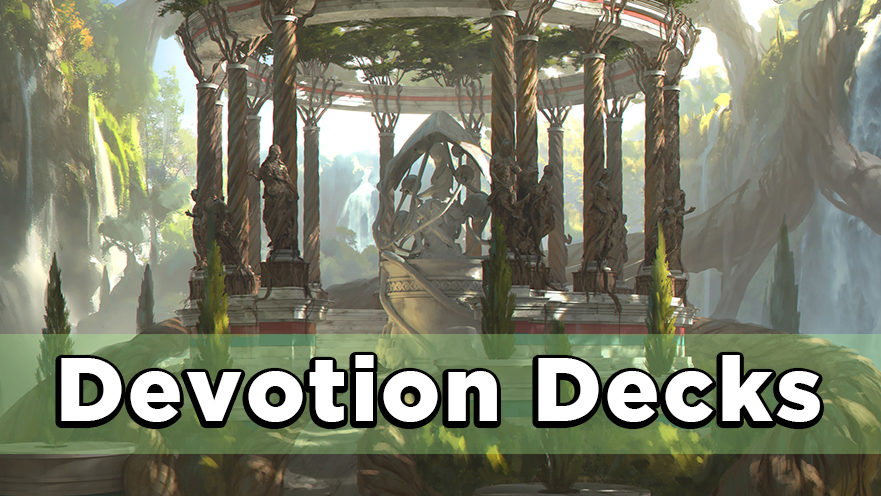Devotion is back in Theros Beyond Death!
Devotion counts the colored mana symbols among permanents you control to make some of your cards more powerful. It’s also a returning mechanic, so we have two years’ worth of precedent for what works and what doesn’t. We know that some cards with devotion are so powerful that they incentivize you to fill other slots in your deck with weaker cards with lots of colored mana symbols.
So, we shouldn’t just be asking ourselves which devotion payoffs to build around. The more important question is: What ways do we have to enable devotion?
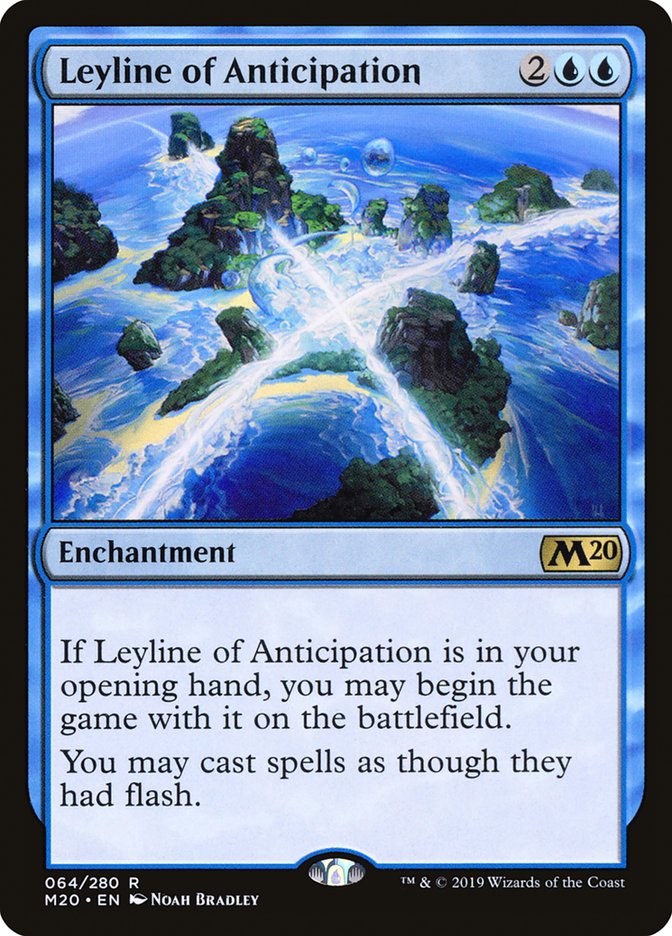
The Leylines are a set of enablers we didn’t have in the original Theros block. Powering up devotion cards without spending mana is intriguing, but probably not enough if neither the payoff nor the effect on the Leyline itself is worth it. (This goes for other weak cards with multiple mana symbols of a color, too). The rare legends and uncommon hybrid cards from Throne of Eldraine and the demigods from Theros Beyond Death can help enable devotion, too.
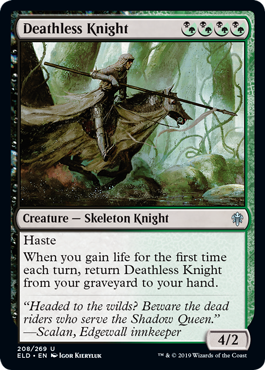
In short, playing a lot of cards with two colored mana symbols is generally a good idea. However, we should keep in mind that the overall power level of this format is higher than it was during Theros. It’s less likely that we can get away with playing cards like Frostburn Weird this time around (which was tied with Jace, Architect of Thought for most played nonland card in the Top 8 of Pro Tour Theros).
With that, I’ll be going over three decks: one each for White, Blue, and Black Devotion. Time to get into the decklists!
WHITE DEVOTION
Key Cards
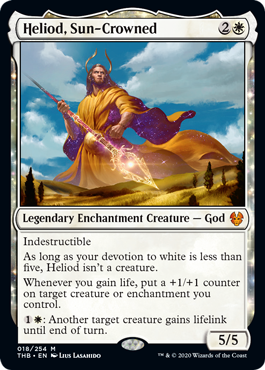
Heliod, Sun-Crowned is the only mono-colored God that costs three mana. This is a good sign for his prospects in Standard, since the best Gods in the past have been ones that can start attacking on turn four (Thassa, God of the Sea and Hazoret the Fervent). If a good shell can be found for Heliod, I expect him to be similarly successful. While Heliod doesn’t grant evasion like Thassa, he has more synergistic potential, with several playable white cards that either gain life or benefit from life-gain.
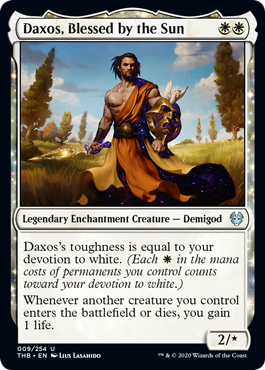
Daxos, Blessed by the Sun is a solid two-drop that synergizes well with Heliod. He will likely be an auto-include in Heliod decks.
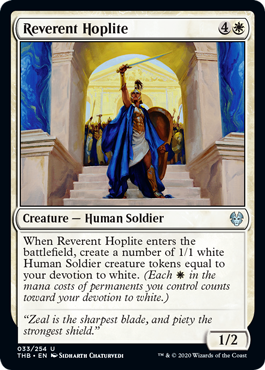
Reverent Hoplite is a powerful effect for five mana. A slower shell with Charming Prince could be a good fit.
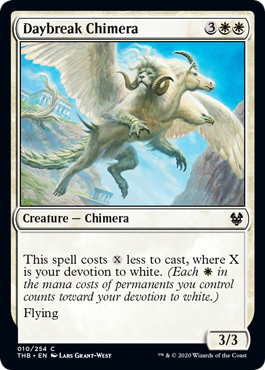
Daybreak Chimera is a nice surprise at common. Like former Aether Vial partner-in-crime Serra Avenger, the Chimera can come down as your second spell on turn 3, at which point a 3/3 flyer is quite a good rate.
If Mono-White Devotion is good, it’s probably because of Heliod. In my initial build, I decided to go with a more aggressive deck in the mold of Theros‘s Mono-Blue Devotion to see if Heliod is a worthy successor to the original Thassa. Venerated Loxodon and Linden, the Steadfast Queen give the deck some consistency in getting ahead on board that should help make up for the lack of a second individually powerful devotion card.
Mono-White Devotion
4 Alseid of Life’s Bounty
4 Giant Killer
4 Faerie Guidemother
4 Healer’s Hawk
4 Ajani’s Pridemate
4 Daxos, Blessed by the Sun
4 Heliod, Sun-Crowned
4 Linden, the Steadfast Queen
4 Venerated Loxodon
1 Elspeth, Sun’s Nemesis
2 Banishing Light
1 Castle Ardenvale
20 Plains
BLUE DEVOTION
Key Cards
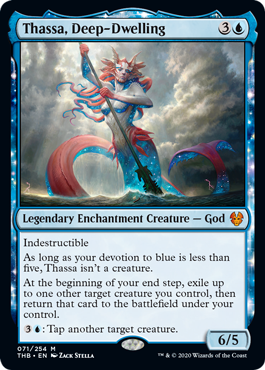
Thassa, Deep-Dwelling almost seems more at home in a deck that doesn’t use devotion at all. Her effect is reminiscent of Soulherder from Modern Horizons, which is powerful enough to see fringe play in Modern. Plus, with Risen Reef and Agent of Treachery to generate value, I wouldn’t be shocked if she sees play in small numbers in a deck like Simic Ramp. In a dedicated devotion deck, she’s a 6/5 for four mana that has strong synergy with a couple cards in the format, particularly Thassa’s Oracle.
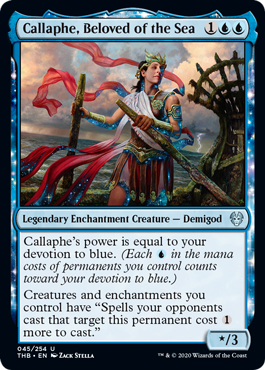
Callaphe, Beloved of the Sea succeeds in one area where Brineborn Cutthroat falls flat: she gets big right away, rather than over time. With just one Thassa’s Oracle or Leyline of Anticipation in play, Callaphe is a 4/3 that protects herself and your other creatures for three mana.
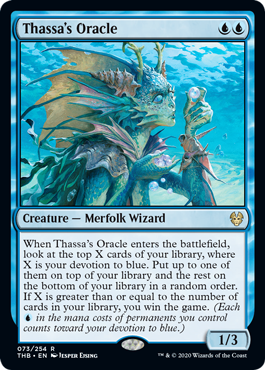
Thassa’s Oracle allows Blue Devotion decks to find Callaphe or Thassa more consistently. It also has two blue symbols to power them up, it’s good with Thassa’s “flicker” effect, and it gets better post-board when it can find powerful sideboard cards. I think this is the best two-drop for a mono-blue deck with Callaphe and Thassa.
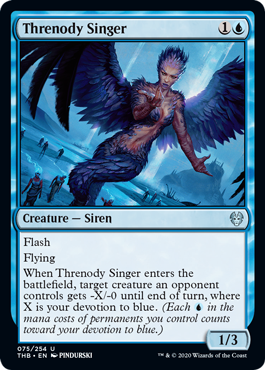
Threnody Singer’s value goes up if there are a lot of aggressive decks in the format. With only one power, it seems hard to blow opponents out by flashing it in after attacks, but it might be a sideboard all-star against aggressive decks that rely on one-toughness creatures.
I drew the inspiration for this deck from Evart Moughon’s Mono-Blue Flash deck in Pioneer. I tried building with Arcanist’s Owl to find Callaphe and Thassa, but curving a four-mana 3/3 flyer into Thassa seemed a bit too slow, and I don’t want to have to play four copies of Stinging Lionfish and Wavebreak Hippocamp to give the Owl enough good hits. I would likely play four Threnody Singer in the sideboard – although it seems better than Brineborn Cutthroat against aggressive decks, I want a two-drop that lets me play an aggressive role against slower decks in game one.
Mono-Blue Devotion
4 Spectral Sailor
4 Brineborn Cutthroat
4 Thassa’s Oracle
4 Brazen Borrower
4 Callaphe, Beloved of the Sea
1 Wavebreak Hippocamp
4 Gadwick, the Wizened
4 Thassa, Deep-Dwelling
2 Quench
3 Leyline of Anticipation
2 Thassa’s Intervention
BLACK DEVOTION
Key Cards
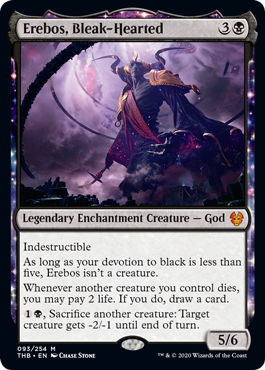
Erebos, Bleak-Hearted looks strong with Witch’s Oven and Cauldron Familiar, and with Gray Merchant of Asphodel. But, in some ways, Erebos seems like a trap. A big creature without evasion isn’t so good in a sacrifice deck, the cost to draw cards is steep, and the sacrifice ability has issues both with finding fodder and with killing relevant creatures after turn four. A 6/5 with indestructible for four is no joke, though, and his abilities may be good enough even when he isn’t a creature.
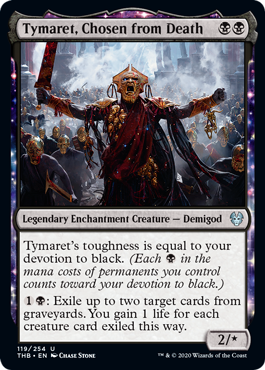
Tymaret, Chosen from Death looks powerful at first glance, but the last ability is less efficient than similar effects we’ve seen (such as on Withered Wretch and Scavenging Ooze). Spending two mana to exile two cards will cost you more resources than your opponent has to use to save their Cauldron Familiar. That said, Tymaret still has a serviceable defensive body with two black symbols and an incidentally good ability, and I won’t be surprised if he sees some play in a devotion deck.
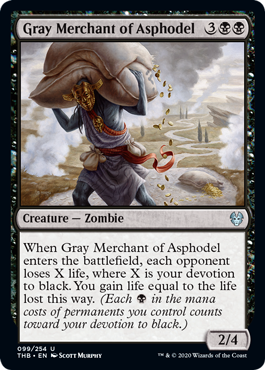
Gray Merchant of Asphodel is back! And “Gary” has some new friends in Ayara and company. Many players feel that Gary will be at his best in Bolas’s Citadel decks, but I like the idea of pressuring opponents’ life totals with a combination of Gary and Mayhem Devil.
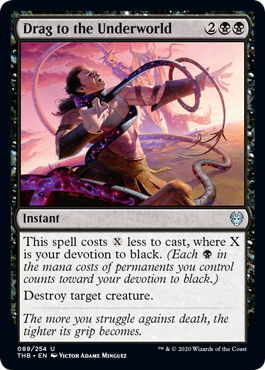
Drag to the Underworld looks good if we can cast it for two mana. It is missing an important feature that makes two-mana removal spells like Cast Down, Grasp of Darkness, or Ultimate Price good: you can never cast it on turn two. This card might still see some play in decks that can expect a two-mana discount, particularly ones that aren’t satisfied with four Murderous Riders. Murder is rarely played in Standard, so you really want the discount to push this over the top.
All four of these cards look like potential fits for an aggressive-ish black deck. Nightmare Shepherd also looks scary with Gary, especially when a sacrifice outlet gets involved. Token copies still have a mana cost, so a curve like Woe Strider into Nightmare Shepherd into Gary drains for 10 immediately, and the 4/4 flyer could help finish the game off!
Black-Red Devotion/Sacrifice
4 Cauldron Familiar
4 Witch’s Oven
3 Tymaret, Chosen by Death
1 Kroxa, Titan of Death’s Hunger
4 Mayhem Devil
2 Murderous Rider
4 Woe Strider
3 Ayara, First of Locthwain
4 Nightmare Shepherd
1 Erebos, Bleak-Hearted
4 Gray Merchant of Asphodel
1 Bolas’s Citadel
4 Castle Locthwain
4 Temple of Malice
4 Fabled Passage
1 Mountain
4 Blood Crypt
8 Swamp
Of these decks, I think Black-Red has the best chance at succeeding in Standard. I can’t see the future like Kruphix, but I’m excited to watch the devotion decks play out!

Felix Sloo, also known as “xfile,” is a Magic Online grinder known for his innovative deck-building. Though he tends to play popular decks like Simic Urza, Hogaak, and Sultai Food, he earned his first Grand Prix Top 8 at MagicFest Portland 2019, where he was the only player in the tournament to register Leyline Prowler.

